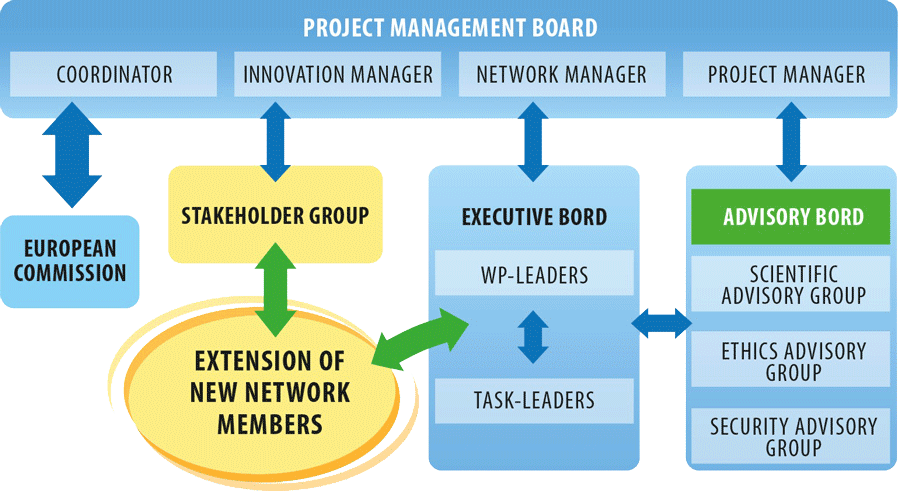
EU-HYBNET
Empowering a Pan-European Network to Counter Hybrid Threats

Empowering a Pan-European Network to Counter Hybrid Threats
Project management’s main goal is to provide a focused, timely and flexible but effective framework to achieve EU-HYBNET’s objectives. To this aim, a management structure is in place, along with a set of principles and procedures which, whilst being as flexible and agile, will leave little room for subjective interpretation. The main focus will be directed at optimizing the allocation of resources, by creating an appropriate management framework linking key project components, and on ensuring that all aspects of the reporting requirements to the EC are met.
The project will be run by a clear set of procedures, based on effective information exchange. Generally speaking, consensus will be reached through cordial discussions. If required, agreement will be reached by majority vote ensuring that any final decisions are in keeping with project objectives. The key responsibilities and decision making processes inherent in the project management structure are depicted in the figure below.

The Project Management Board (PMB) is comprised of the coordinator (PC) and three managers: Project Manager (PM), Innovation Manager (IM), and Network Manager (NM). Although all members of the PMB have voting rights, the PC has final decision making power in the event a consensus cannot be arrived at.
PMB will be responsible for strategic decision making, monitoring project progress, and, if necessary, following up and correcting any project mishaps, and anticipating emerging conflicts and dealing with these preemptively.
These responsibilities will be executed together with the project’s Executive Board (EB). In addition, the project’s three Project Advisory Groups (3AG) will provide advice and guidance in their respective areas of scientific, ethical, and security related expertise, but will not participate directly in the decision making processes. Roles and responsibilities and importance of the EB and the 3AGs, who form the second layer in project execution, are described below.
The project Executive Board (EB) consists of the project Work Package (WP) leaders, as well as Task leaders (T), and hence directly involves the key actors in the project and encompasses the major activities in project execution. As such, the EB is central not only to effective project monitoring, but also to decision making procedures in conjunction with the PMB. The specific responsibilities of the EB are as follows:
Project monitoring, progress and decision making is also supported by three Project Advisory Groups (3AG): Ethical Advisory Group (EeAG), Scientific Advisory Group (ScAG) and Security Advisory Group (SeAG).
Their roles and functions are as follows:
The PMB and EB alongside the 3AGs are supported by an external Advisory Board (AB) to whom PMB reports on a regular basis on project progress and cooperative interactions with EB, EeAG, ScAG, and SeAG. The PMB also keeps the Stakeholder Group (SG) members informed of project progress and any new memberships in the SG which forms the core of the European Network against Hybrid Threats. The AB and SG include members outside the partner consortium and hence they have own nature in the second layer of the project management structure.
The Advisory Board (AB) meets once a year with project members and is made up of selected individuals with a wealth of experience and know-how from European and International organisations not directly involved in the project’s day-to-day activities.
In close cooperation with the project coordinator (PC), and together with PMB, the AB will advise on strategic directions of the project with reference to objectives and goals, impacts, key research areas, most promising innovations and recommendations as regards bridging gaps and fulfilling needs; as well as assessing recommendations regarding innovation uptake and standardisation, or reviewing the conclusions arising from discussions around ethical and societal considerations, and providing critical feedback. To achieve high quality results within the EU-HYBNET project, strong and active cooperation with AB members will be pursued and facilitated by frequent interaction.
The Stakeholder Group (SG) is also a vital part of the EU-HYBNET project. SG members are considered associate partners (i.e. the organisations that are committed to supporting the objectives of EU-HYBNET). The patterns manifested by hybrid threat onslaughts are in constant flux, and these threats affect many different types of institutions from representatives of governments, ministries, law enforcement agencies and other national and international authorities, through to municipal institutions and local authorities, NGOs, universities and so on. For this reason there are many challenges in accurately predicting threat occurrences in forthcoming project years. This is why EU-HYBNET has established an SG which includes a variety of practitioner organisations and actors (industry, SMEs, academic actors, NGOs) who are dealing constantly with European measures in the fight against hybrid threats. Currently, SG membership includes sixteen (14) European actors and two (2) from Associated Countries who form the basis next to the consortium to the empowerment of European network countering hybrid threats.